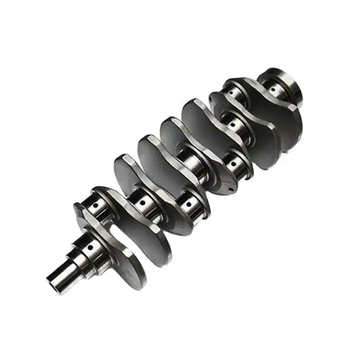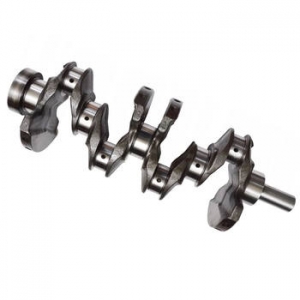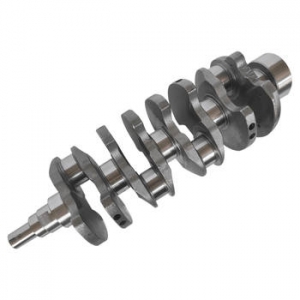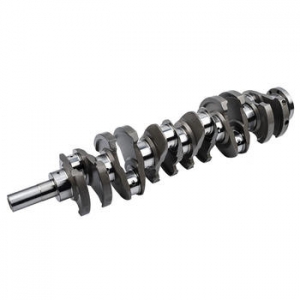Finding the Right Crankshaft Manufacturer: A Deep Dive into Quality and Craftsmanship
When you think about the heart of an internal combustion engine, many components come to mind: pistons, valves, connecting rods. But arguably, one of the most critical, and often overlooked by the casual observer, is the crankshaft. This intricate piece of engineering is responsible for converting the linear motion of the pistons into rotational motion, which ultimately drives your vehicle or powers machinery. Frankly speaking, without a properly designed and manufactured crankshaft, your engine simply wouldn't run. This is why the role of a skilled crankshaft manufacturer is absolutely paramount.
Choosing the right partner for such a vital component isn't a decision to be taken lightly. Whether you're building high-performance racing engines, developing heavy-duty industrial machinery, or producing standard automotive powerplants, the quality and reliability of the crankshaft directly impact the engine's efficiency, durability, and overall performance. Let's take a closer look at what goes into this crucial component and what you should consider when seeking a top-tier crankshaft manufacturer.
What Exactly is a Crankshaft and Why is it So Important?
At its core, a crankshaft is a mechanical part that converts reciprocating motion into rotational motion. Imagine the pistons moving up and down in the cylinders. Connecting rods link these pistons to the crankshaft. As the piston moves down after combustion, it pushes the connecting rod, which in turn rotates the crankshaft. This rotation is then transmitted through the drivetrain to power the wheels or other driven components.
It's worth noting that the crankshaft is subjected to immense forces and stresses during operation. It endures torsional loads from the engine's power pulses, bending loads from the connecting rods, and centrifugal forces from its own rotation. Because of these demanding conditions, the material science, design precision, and manufacturing quality are non-negotiable. A failure here can lead to catastrophic engine damage. Have you ever wondered about the incredible forces at play inside an engine running at thousands of revolutions per minute? The crankshaft is right at the center of that controlled chaos, managing and converting all that energy. This highlights why relying on an experienced crankshaft manufacturer is essential.

The Complex Journey: The Crankshaft Manufacturing Process
Creating a crankshaft is a multi-stage process that requires high levels of precision, advanced metallurgy, and sophisticated machinery. It's far more than just shaping a piece of metal. Many experts agree that the complexity lies in achieving the extremely tight tolerances required for balance, straightness, and journal finish. Let's break down the typical steps involved in what a leading crankshaft manufacturer undertakes.
Material Selection and Preparation
The process begins with selecting the right material. High-strength steel alloys are commonly used, such as forged steel (like 4340 or 5140) for high-performance and heavy-duty applications, or cast iron (often nodular or ductile iron) for more standard production engines. The choice depends heavily on the intended application, required strength, and cost considerations. The raw material arrives in the form of billets or ingots.
Forging or Casting
There are two primary methods for forming the basic shape of the crankshaft:
- Forging: This involves heating the steel billet to a high temperature and then shaping it using dies and powerful presses. Forging aligns the material's grain structure along the shape of the crankshaft, resulting in a stronger, more durable part, ideal for demanding applications.
- Casting: Molten iron or steel is poured into a mold shaped like the crankshaft. While generally less expensive than forging, cast crankshafts are typically used in less stressed applications.
Both processes require careful control of temperature and pressure to ensure the material properties are optimized.
Machining
After forging or casting, the rough form undergoes extensive machining. This is where the precise dimensions are achieved.
- Rough Machining: Excess material is removed to get closer to the final shape.
- Finish Machining: This involves highly accurate processes like turning, milling, and grinding to create the main bearing journals (where the crankshaft rotates in the engine block) and the rod journals (where the connecting rods attach). Tolerances here are often measured in microns.
- Hole Drilling: Oil passages are drilled through the crankshaft to ensure lubrication reaches all critical bearing surfaces.
This stage is critical for the geometry and fit of the crankshaft. Precision machining is a hallmark of quality custom crankshaft manufacturing.
Heat Treatment
To enhance strength, hardness, and wear resistance, crankshafts undergo heat treatment. Common methods include:
- Nitriding: A surface hardening process that diffuses nitrogen into the steel, creating a very hard outer layer while keeping the core tough.
- Fillet Rolling/Shot Peening: These processes induce compressive stress on the surface, particularly in critical areas like the fillets (the transitions between journals and crank arms), which significantly improves fatigue strength.
Balancing
A crankshaft must be perfectly balanced to minimize vibration during high-speed rotation. Even slight imbalances can cause excessive wear and engine damage. Balancing is done by adding or removing material from specific points on the crankshaft's counterweights. This is often an iterative process using specialized balancing machines.

Inspection and Quality Control
Throughout the entire process, rigorous inspection is performed. This includes dimensional checks, surface finish analysis, magnetic particle inspection (to detect cracks), ultrasonic testing, and material property verification. A reputable crankshaft manufacturer will have stringent quality control procedures at every step to ensure the final product meets or exceeds specifications.
The entire journey, from raw material to finished product, is a testament to precision engineering and manufacturing expertise.
Choosing Your Partner: Key Considerations for Selecting a Crankshaft Manufacturer
With the complexity involved, selecting the right crankshaft manufacturer is paramount. Here are some key factors to consider:
- Experience and Reputation: Look for manufacturers with a proven track record in your specific industry (automotive, marine, industrial, etc.). Experience translates into understanding the unique demands and standards of different applications. I've found that manufacturers who specialize often offer deeper expertise.
- Technology and Equipment: A leading manufacturer invests in state-of-the-art forging/casting equipment, precision CNC machining centers, advanced heat treatment facilities, and sophisticated inspection tools. Outdated equipment can compromise quality and consistency.
- Material Expertise: They should have a deep understanding of various steel alloys and cast irons, and be able to recommend the best material for your application's performance requirements and budget.
- Quality Control and Certifications: Ask about their quality management system. Certifications like ISO 9001 or IATF 16949 (for automotive) are strong indicators of a commitment to quality processes. Their inspection protocols should be thorough.
- Customization Capabilities: If you require non-standard or high-performance designs, look for capabilities in custom crankshaft manufacturing. This includes design assistance, prototyping, and the ability to work with specific material requirements.
- Production Capacity and Lead Times: Can they meet your volume requirements, whether low-volume custom runs or high-volume production? What are their typical lead times?
- Customer Service and Support: A good partner offers technical support, clear communication, and responsive service throughout the process.
- Cost: While not the only factor, cost is important. However, prioritize value over just the lowest price. A cheap crankshaft can end up being far more expensive in the long run due to failures and warranty issues.
To be honest, evaluating these factors requires due diligence. Visiting the manufacturer's facility, talking to their engineers, and requesting samples or references can provide valuable insights. When seeking high-performance crankshaft suppliers, these criteria become even more critical, as the demands on the component are significantly higher.
Types of Crankshafts and Their Applications
Crankshafts come in various configurations depending on the engine design (inline, V-engine, flat engine), the number of cylinders, and the firing order.
- Inline Engine Crankshafts: Relatively straightforward designs with journals arranged linearly.
- V-Engine Crankshafts: More complex, often featuring shared rod journals (pin journals) for pairs of cylinders.
- Flat Engine Crankshafts: Unique designs for horizontally opposed cylinders.
- Single Cylinder Crankshafts: Simpler designs found in motorcycles, small engines, etc.
Beyond the configuration, crankshafts are also categorized by their application and performance level:
- Standard Production Crankshafts: Designed for reliability and cost-effectiveness in mass-produced vehicles or equipment. Often cast iron.
- Performance Crankshafts: Built for higher horsepower, torque, and RPM applications. Typically forged steel, with enhanced heat treatment, balancing, and material properties. This is where specialized high-performance crankshaft suppliers excel.
- Heavy-Duty Crankshafts: Designed for large diesel engines in trucks, marine vessels, and industrial equipment, built to withstand extreme loads and long operating hours.
- Custom Crankshafts: Tailored for unique engine builds, racing applications, or specialized industrial uses where off-the-shelf options aren't suitable. This is the domain of custom crankshaft manufacturing.
The specific requirements for an automotive crankshaft production process differ significantly from those for a large marine diesel engine crankshaft, highlighting the need for manufacturers with relevant industry experience.
The Future Landscape for a Crankshaft Manufacturer
The world of engines is constantly evolving, and so too is the role of the crankshaft manufacturer. While electric vehicles are gaining traction, internal combustion engines will remain vital for many applications for the foreseeable future, especially in heavy transport, industrial machinery, and certain segments of the automotive market.
Future trends include:
- Material Innovation: Development of even stronger, lighter alloys to improve engine efficiency and performance.
- Advanced Manufacturing Techniques: Increased use of automation, robotics, and potentially additive manufacturing (3D printing) for complex geometries or rapid prototyping, though mass production remains largely traditional for now.
- Improved Simulation and Design: More sophisticated computer modeling to optimize crankshaft design for stress, vibration, and weight reduction before physical prototyping.
- Tighter Emissions Standards: Driving the need for more precise engine components that contribute to greater combustion efficiency.
A forward-thinking crankshaft manufacturer will be investing in these areas, staying ahead of technological curves and market demands.
Conclusion
The crankshaft is an unsung hero of the engine world, a marvel of engineering that endures incredible stress with every revolution. Its reliable operation is fundamental to the performance and longevity of any engine. Choosing the right crankshaft manufacturer is not merely a procurement decision; it's selecting a critical partner whose expertise, technology, and commitment to quality will directly impact the success of your product or project. From the careful selection of raw materials and the precision of the forging or casting process, through meticulous machining, heat treatment, balancing, and rigorous inspection, every step requires mastery. Whether you need standard components, are exploring custom crankshaft manufacturing, or seeking high-performance crankshaft suppliers, thorough evaluation of potential partners is essential. The future of engine technology will continue to demand innovation and precision from these vital manufacturers.
For more detailed information, please visit our official website:Crankshaft manufacturer
About the author: John Doe is a mechanical engineer with over 15 years of experience in powertrain design and manufacturing. He has worked with leading automotive and industrial companies, specializing in the development and production of critical engine components like crankshafts. His expertise lies in material science, precision machining, and quality assurance for high-stress applications.
 The Ultimate Guide to Getting
The Ultimate Guide to Getting
 The Unsung Heroes: Unveiling t
The Unsung Heroes: Unveiling t
 Unlocking Power: A Deep Dive i
Unlocking Power: A Deep Dive i
 The Ultimate Industrial Cranks
The Ultimate Industrial Cranks
